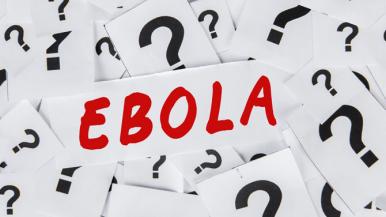If you've paid any attention to the news at all, you've seen and heard dramatic stories about the outbreak of Ebola in Africa and a handful of cases diagnosed in the U.S.
Because Ebola is fatal in at least half of all cases and the symptoms are horrendous, a lot of people are alarmed by the disease.
But while it's natural to be afraid, there's no need for full-blown panic. Here, Dino Rumoro, DO, MPH, chairperson of the Rush Department of Emergency Medicine, and emergency room physician Yanina Purim-Shem-Tov, MD, explain why.
Q: Are you worried now that Ebola has appeared in the U.S.?
Rumoro: There are a lot of diseases that cause us a lot of concern. In the '80s, the emergence of HIV/AIDS made health care workers very nervous as well, and yet we learned how to deal with it. Our experience dealing with other infectious diseases has prepared us to deal this disease.
One of the biggest problems in the Third World countries (like Africa) is they don't have the technology and personal protective equipment we have at hospitals in the U.S.
So while my colleagues and I are taking Ebola very seriously, we are also well-equipped to treat patients.
Q: A lot of people are concerned about getting Ebola? How is the virus spread?
Purim-Shem-Tov: Ebola is spread through direct contact with the body fluids of someone infected with the virus — and that person won't be contagious until he or she begins to exhibit symptoms. It's not spread through the air. In other words, unless a person who's already sick with Ebola gets body fluids (vomit, feces, blood, spit, sweat, etc.) on a break in your skin, or in your eyes, nose or mouth, you're not going to get Ebola.
If an asymptomatic person is just in the incubation period, then you don't have to worry about catching Ebola from that person. So, for instance, if you are sitting next to a person on a plane who is in the incubation period, you are not going to catch Ebola from that person.
Q: Who's at risk for Ebola?
Rumoro: Anyone who comes in direct contact with body fluids of an infected person is at risk.
- Health care workers are at higher risk, just because they're getting in close contact with body fluids.
- A close family member who may be caring for a patient is at even higher risk than a health care worker, because they don't have the personal protection health care workers use. Family members, if they're cleaning up the diarrhea or the blood, might think, "it's part of my job," and may ignore the need to protect themselves.
While Ebola is a highly dangerous and infectious disease, health care workers can control it by using blood and body fluid precautions. We want to protect ourselves from any type of secretion. Most people will be fine wearing standard personal protective equipment (PPE) of gloves, yellow gown and mask with face shield.
For staff exposed to bodily fluids, higher levels of PPE are available. Currently, extended staff training of proper use of PPE is under way. It is also expected that standard precautions be taken by all staff including washing our hands frequently.
There's reason to exercise caution. But with the proper equipment, and if health care workers follow the rules, they'll be safe and, as a result, can keep patients and the community safe.
While my colleagues and I are taking Ebola very seriously, we are also well-equipped to treat patients.
Ebola: What You Should Know
- Ebola does not spread through the air, water or, in general, by food. It is transmitted through direct contact with bodily fluids of an infected person or through droplets that can be transmitted by close contact (3 feet or less).
- Vomit, urine and diarrhea from sick patients are highly infectious. Other body fluids like sweat, saliva, tears, semen and breast milk also contain the virus.
- People without direct contact with a very sick Ebola patient’s bodily fluids are extremely unlikely to become infected. Direct contact means that the fluids from a patient are splashed or sprayed into someone else’s mouth, eyes or nose, or enter the bloodstream through cuts or breaks in the skin.
- People also can contract the disease by touching infected fluids and then touching their eyes or mouths, or by using a needle or syringe that has been contaminated with the virus.
- Early symptoms may include fever, intense weakness, muscle pain, headache and sore throat.
- Later symptoms may include vomiting, diarrhea, rashes, impaired liver and kidney function, and, in some cases, internal and external bleeding.
- Ebola is not contagious during the incubation period (the time between infection and when symptoms first appear), and patients do not transmit it until they develop symptoms.
- Symptoms may appear anywhere from 2 to 21 days after exposure to Ebola, but the average is 8 to 10 days.
- Currently, there is no antiviral medication to treat Ebola. Recovery from Ebola depends on supportive medical care and the patient’s immune response. Many patients recover with appropriate medical care.
- According to the Centers for Disease Control (CDC), there is no evidence that mosquitos or other insects can transmit Ebola virus. Only mammals (for example, humans, bats, monkeys, and apes) have shown the ability to become infected with and spread Ebola virus.
- Animals aren't spreading Ebola. There have been no reports in Africa or the United States of dogs and cats becoming sick with Ebola, or spreading Ebola to people or other animals.




